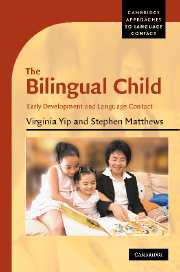Book contents
- Frontmatter
- Contents
- List of tables and figures
- Series editor's foreword
- Preface
- Acknowledgments
- List of abbreviations
- 1 Introduction
- 2 Theoretical framework
- 3 Methodology
- 4 Wh-interrogatives: to move or not to move?
- 5 Null objects: dual input and learnability
- 6 Relative clauses: transfer and universals
- 7 Vulnerable domains in Cantonese and the directionality of transfer
- 8 Bilingual development and contact-induced grammaticalization
- 9 Conclusions and implications
- References
- Index
- Author index
7 - Vulnerable domains in Cantonese and the directionality of transfer
Published online by Cambridge University Press: 08 January 2010
- Frontmatter
- Contents
- List of tables and figures
- Series editor's foreword
- Preface
- Acknowledgments
- List of abbreviations
- 1 Introduction
- 2 Theoretical framework
- 3 Methodology
- 4 Wh-interrogatives: to move or not to move?
- 5 Null objects: dual input and learnability
- 6 Relative clauses: transfer and universals
- 7 Vulnerable domains in Cantonese and the directionality of transfer
- 8 Bilingual development and contact-induced grammaticalization
- 9 Conclusions and implications
- References
- Index
- Author index
Summary
Child: Je4sou1 bei2 (ng)o5 cin2 aa3 ‘Jesus gave me money.’
Adult: Je4sou1 bei2 cin2 lei5 aa4? ‘Jesus gave you money?’
Child: Hai6 aa3 ‘Yes he did.’
Adult: Bin1go3 bei2 cin2 lei5 aa3? ‘Who gave you money?’
Child: Hai6 Je4sou1 bei2 (ng)o5 cin2 ‘It was Jesus who gave me money.’
(Sophie 2;05;02)The above Cantonese dialogue between Sophie at two years five months and the adult researcher illustrates how the child's grammar is different from the adult's. Sophie's sentence shows a non-target word order: Je4sou1 bei2 ngo5 cin2 ‘Jesus gave me money,’ where the recipient ngo5 ‘me’ immediately follows the verb bei2 ‘give’ and the object cin2 ‘money’ in turn follows the recipient. She repeats this despite the adult's word order in Je4sou1 bei2 cin2 lei5 aa4? ‘Jesus gave you money?’ and Bin1go3 bei2 cin2 lei5 aa3? ‘Who gave you money?’ where the object cin2 ‘money’ immediately follows the verb bei2 ‘give’ and the recipient lei5 ‘you’ appears as the second object. In section 7.2.1 we shall see that our bilingual children have a strong tendency to produce the Cantonese double object construction with bei2 ‘give’ in the non-target word order, which in turn resembles the English counterparts. This is one of the few grammatical domains that show cross-linguistic influence from English, the weaker language to Cantonese, the dominant language: the reverse of the typical pattern of transfer as discussed in the preceding chapters.
The clear cases of transfer discussed in the preceding chapters involve Cantonese structures being transferred to English.
- Type
- Chapter
- Information
- The Bilingual ChildEarly Development and Language Contact, pp. 189 - 226Publisher: Cambridge University PressPrint publication year: 2007

